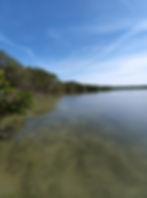Florida again eyes mangroves as key to coastal resilience in new legislation
- studentbylines
- 2 hours ago
- 3 min read
Mangroves provide multiple benefits to Florida’s threatened coasts

Throughout her life, Brooke Gaebe has trekked through mangrove forests to watch the sun dawn over the horizon and turn the sea golden from underneath the trees. As a certified forest therapy guide who spent the majority of her life in the rich ecological diversity of south Florida, Gaebe understands that mangrove trees are multifaceted, providing everything from lush habitats for wildlife to mental relief.
“If you spend enough time in a mangrove forest, you can feel this human connection– almost to your ancestors,” Gaebe said.
Florida lawmakers also are paying attention to the power of mangroves to improve coastal resilience. A bill instructing the Florida Department of Environmental Protection to develop guidelines for nature-based solutions to improve coastal resilience has passed the Sentate and is now moving through the House of Representatives (comparative – HB 371).
SB50, sponsored by Sen. Ileana Garcia (R-Miami), would task the University of South Florida with setting standards for “hybrid green-gray” infrastructure. Garcia introduced bills in the previous two legislative sessions to buffer mangrove planting and restoration in particular parts of Florida. Both years, those bills died in session.

Planting more mangroves, which distribute wave energy and prevent storm surge, is one of the key solutions proposed in the bill. The “green” mangroves and other native shoreline vegetation are tools to strengthen Florida’s coastline in conjunction with “gray,” man-made infrastructure. Nature-based “green” solutions slowly build coastal resilience and provide habitats as they become mature ecosystems, while “gray” infrastructure provides immediate prevention in the interim time that it takes for green infrastructure to mature.
Florida is increasingly vulnerable to sea level rise and storm surges during hurricanes and tropical storms. Sea levels have been rising at an accelerated rate in Florida, with one projection estimating an increase of 10-12 inches over the next 30 years, according to the Florida Climate Center. In 2024, Hurricanes Helene and Milton caused billions of dollars in damage in the Big Bend and Gulf Coast.
Both sea level rise and increased storm surge pose threats to drinking water, drainage systems, and infrastructure.
Maya Trotz is a professor of civil and environmental engineering at the University of South Florida has worked extensively with nature-based solutions, including mangroves.
“As [hybrid green-gray] ecosystems mature, their performance at reducing things like storm surge could be equivalent or better than gray infrastructure,” Trotz said.
Gray infrastructure, like sea walls, doesn’t provide much room for natural ecosystems to flourish. However, using green and grey infrastructure together provides multiple benefits for ecosystems, including providing habitats for fish, improvements in clean water and increased tourism, all while making the coast more resilient long-term.
Nature-based solutions like these are already working in Florida. At the University of Miami, Landolf Rhode-Barbarigos leads the Seahive project, which is designed to provide more sustainable and efficient protection for infrastructure on the coast threatened by storm surge.

The Seahive is composed of concrete beehive-inspired hexagonal tubes that allow water to circulate within them and absorb wave energy, rather than bounce it back like seawalls and rocks do. They also support the growth of coastal plants like mangroves.
If Florida adopts this bill, the nature-based solutions could look like this, equally combining gray and green infrastructure to protect the coast and adapted to the specifics of the local environment.
“We first have to consider what the natural ecosystem is, and then consider what we are looking to protect,” Rhode-Barbarigos said. “We first have to assess the needs the areas have, and work with the local environment and ecology.”
It’s crucial for people who are implementing these solutions to have realistic expectations, he said.
“Natural systems require time to establish and deliver their full protective benefits,” Rhode-Barbarigos said. “This is where hybrid solutions become valuable, offering immediate protection through their engineered human-made components while the natural components establish and provide supplementary benefits.”
In other words, protecting mangroves provides short-term gains with long-term insight.
This story was originally edited by mentor Ashira Morris.






